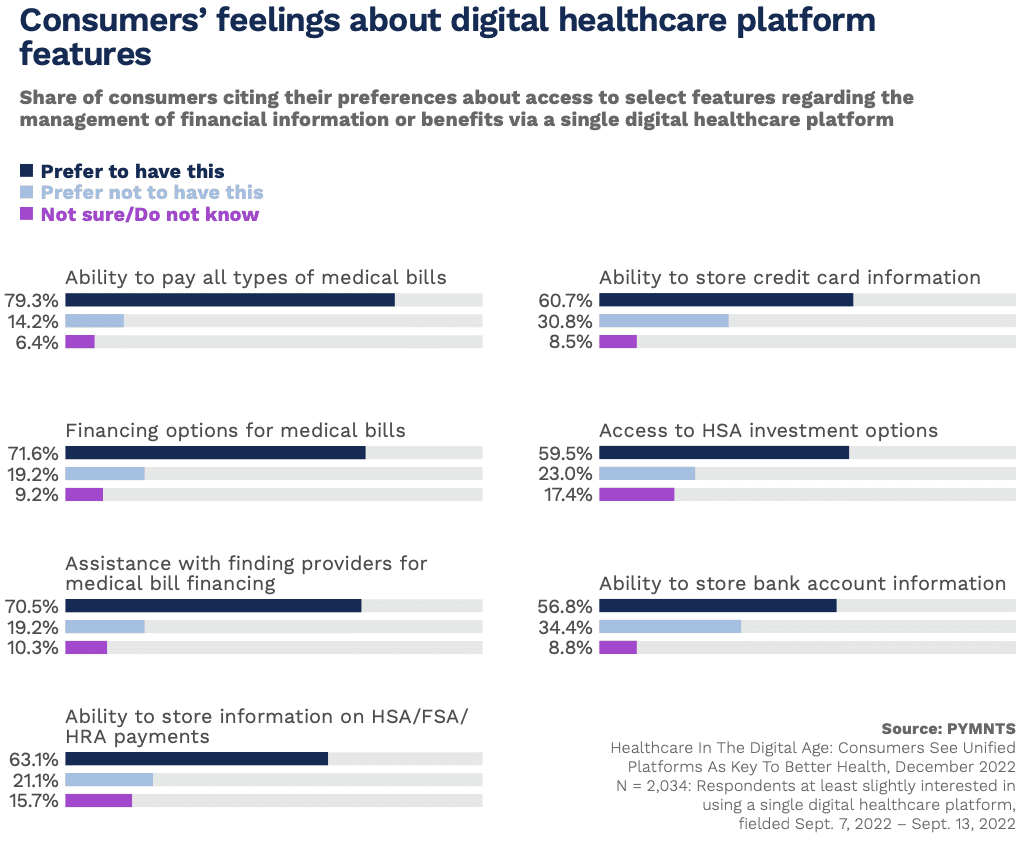Consumers See Healthcare Super App as Cure for Fragmented Experience

The key to better medical care looks to be better information all in one place.
That’s according to recent research in PYMNTS’ December report “Healthcare in the Digital Age,” which found that nearly 80% of consumers want to use a unified digital platform to manage their insurance benefits and information about their care.
Recent industry consolidation, paired with the ongoing digital transformation sweeping across every sector of the economy, is hopefully poised to give it to them, thanks to a string of acquisitions by some of the country’s biggest brands and tech companies.
Buying Spree
Last month, the Walgreens-owned health provider VillageMD announced its acquisition of Summit Health for a staggering $8.9 billion, which operates the CityMD chain of urgent care clinics. The combined City-Village-MD network, as the juxtaposition of names implies, will have a broad geographic reach — counting 680 provider locations across 26 markets.
The VillageMD and Summit Health deal is more than double the size of Amazon’s $3.9 billion acquisition of One Medical, and shows how the industry is reacting to the tech giant’s plans for the sector.
Smaller players are consolidating as well, with Sanford Health and Fairview Health Services merging to create a 58-hospital system serving patients across the Midwest.
What this means for patients and consumers remains to be seen, but it would be smart for these growing provider networks to take advantage of their scale and remove friction points from the consumer experience by shifting to all-in-one digital solutions.
PYMNTS’ research has found that half of consumers have run into difficulties when trying to access health insurance or healthcare services, and 79% of consumers want to pay all their medical bills using a single, digital platform. Additional research from PYMNTS shows that 57% of consumers more generally are interested in paying all of their bills using a single platform.
The nearly-a-quarter (22%) jump in consumer interest around paying more general bills in one place versus paying healthcare bills using a centralized system speaks to the difficulty healthcare consumers currently face: navigating a variety of portals, parsing and filling out one paper form after another, and re-entering information into website after website.
Health platforms storing patient payment information would help. Sixty-one percent of consumers want their credit card information to be stored online, and 57% want the same for their bank account details. These findings are in addition to separate research from PYMNTS showing that 56% of consumers generally believe stored payment details improve the checkout experience.
Improved User Experience
Consumers see multiple advantages to having a healthcare super app. PYMNTS found that 92% of those consumers who reported friction during their payment process are interested in access to unified digital platform to manage their healthcare needs.

Particularly, consumers want the next era of patient care to provide the convenience, speed and control they’ve come to expect across the other areas of their increasingly online lives.
Unified platforms offer clear operational and experiential synergies. Better, easier access to information regarding insurance coverage, billing, medical history, appointment scheduling, pharmacy details and other care-related items can help both providers and patients.
Patients especially tell PYMNTS that a super app would not only help them improve their understanding of, and ability to use, their healthcare benefits, but also support their ability to manage healthcare needs and not be surprised by costs.
82% of consumers who use online healthcare accounts say they don’t just help save time relative to traditional methods, but they are also much more convenient to use.
The creation of such an app will require supporting software and tools to integrate existing, potentially siloed, information into a single, user-facing portal.
Next generation healthcare companies, like virtual care platform Wheel, are leading the charge on this front. Wheel recently purchased GoodRx’s back-end virtual care technology for $19.5 million and plans to integrate GoodRx’s electronic medical record system, clinical management tools and patient experience software into its own nascent single-stop, digital platform.
Giving patients greater control over their information and healthcare experience is also seen as a way to help build better relationships with provider networks, at a time when the healthcare industry is deepening and integrating its digital-first experiences and in-person services, with over-arching digital platforms at the center of it all.